10 Flowers That Flourish in the Chilliest Months of the Year
Winter Flowers
10 Flowers That Flourish in the Chilliest Months of the Year. Winter flowers are flowers that bloom during the winter season. They are a lovely sight to behold, as they bring color and vibrancy to the otherwise cold and dreary winter landscape. These flowers have the ability to withstand the chilly temperatures and continue to bloom, adding beauty and cheer to gardens and floral displays.
Some examples of winter flowers include poinsettia, snowdrops, camellias, hellebores, and winter jasmine. These flowers provide a much-needed burst of color and fragrance during the winter months, reminding us that beauty can thrive even in the coldest of seasons.
10 Flowers That Flourish in the Chilliest Months of the Year
Here are the names of 10 famous winter flowers:
- Poinsettia
- Christmas Cactus
- Winter Jasmine
- Camellia
- Hellebore
- Snowdrop
- Witch Hazel
- Cyclamen
- Winter Aconite
- Lenten Rose
These flowers bring beauty and color to the winter season.
Poinsettia
The poinsettia is native to Mexico and is known for its vibrant red bracts, which are often mistaken as petals. These colorful bracts surround the small yellow flowers at the center.
Poinsettias have a long history of cultural significance. They were named after Joel Roberts Poinsett, the U.S. ambassador to Mexico who played a crucial role in introducing the plant to the United States during the early 19th century. In Mexico, the poinsettia is known as “La Flor de Nochebuena,” meaning “Flower of the Holy Night,” and it is a symbol of the Christmas season.

Apart from the traditional red, poinsettias now come in various colors, including white, pink, and even bi-colored varieties. They are commonly used as decorative plants during the holiday season, adding a festive touch to homes, offices, and public spaces. To keep your poinsettia healthy, it’s important to place it in a location with bright, indirect light and avoid exposing it to drafts or extreme temperatures.
Hydrate the plant when the upper inch of soil appears dry, but exercise caution to avoid overwatering. With proper care, your poinsettia can last beyond the holiday season and continue to bring joy and beauty to your space.
Christmas Cactus
The Christmas cactus, also known as Schlumbergera, is a popular houseplant native to the tropical rainforests of Brazil.
What makes the Christmas cactus unique is its ability to bloom during the winter months, typically around Christmas time, hence the name. Its beautiful flowers come in various colors, including shades of pink, red, white, and even yellow. The flowers are tubular and have pointed petals.
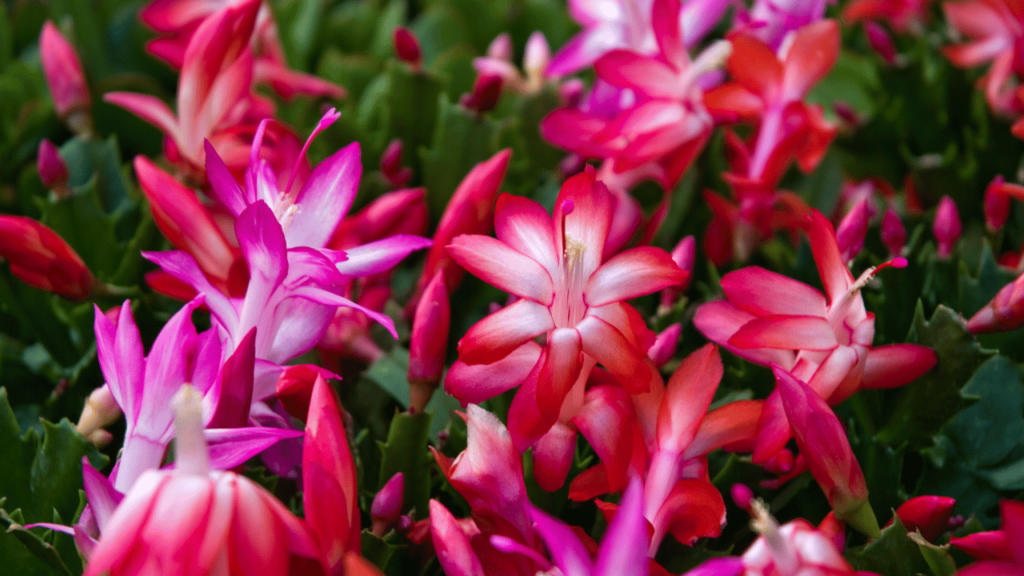
To care for a Christmas cactus, it’s important to provide it with bright, indirect light and keep it in a cool location, away from drafts and extreme temperatures. Unlike other cacti, this variety prefers a bit more moisture, so water it thoroughly when the top inch of soil feels dry. During the blooming period, it’s important to avoid moving the plant too much, as this can cause the buds to drop.
The Christmas cactus is a wonderful addition to your indoor garden, bringing a burst of color and festive cheer during the holiday season.
Winter jasmine
Winter jasmine, scientifically known as Jasminum nudiflorum, is a deciduous shrub native to China.
What makes winter jasmine special is its ability to bloom during the winter months when most other plants are dormant. Its bright yellow flowers appear on bare stems, creating a stunning contrast against the winter landscape. These flowers are small and star-shaped, and they usually grow in clusters. Winter jasmine is a hardy plant that is relatively easy to care for.
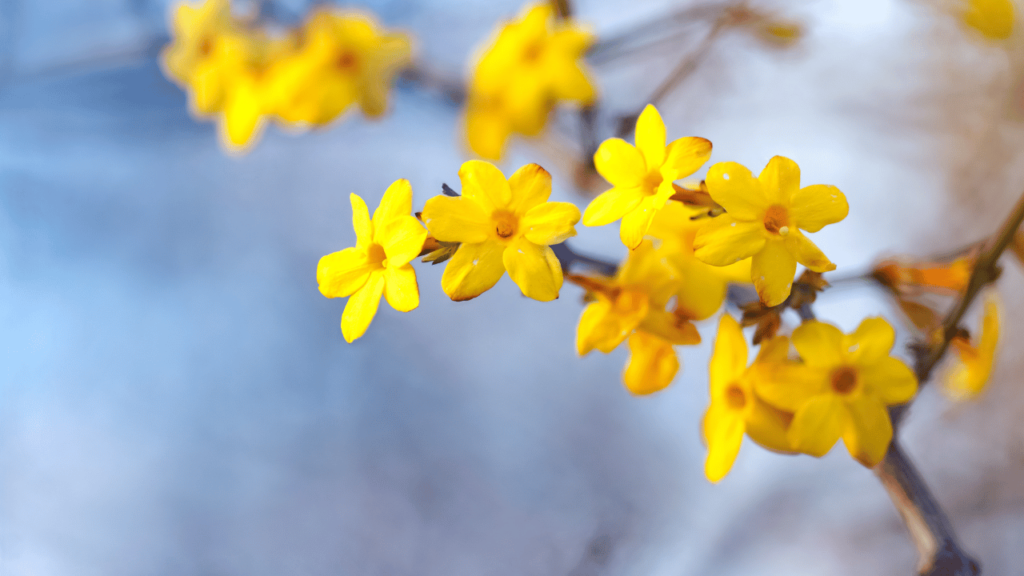
It thrives in full sun to partial shade and benefits from well-draining soil. Once established, it can tolerate a wide range of temperatures, making it suitable for various climates. Pruning is typically performed post-flowering to preserve its shape and stimulate fresh growth.
This beautiful plant can be grown as a ground cover, a climbing vine, or even in hanging baskets. Its vibrant blooms bring a cheerful touch to gardens, balconies, and patios during the colder months
Camellias
Camellias are a type of flowering plant that belongs to the family Theaceae. They are native to eastern and southern Asia, particularly China and Japan.
Camellias are known for their beautiful, showy blooms that come in a wide range of colors, including shades of pink, red, white, and even yellow. The flowers have a symmetrical shape with layers of petals, giving them a lovely, full appearance. Some camellia varieties also have a delightful fragrance.
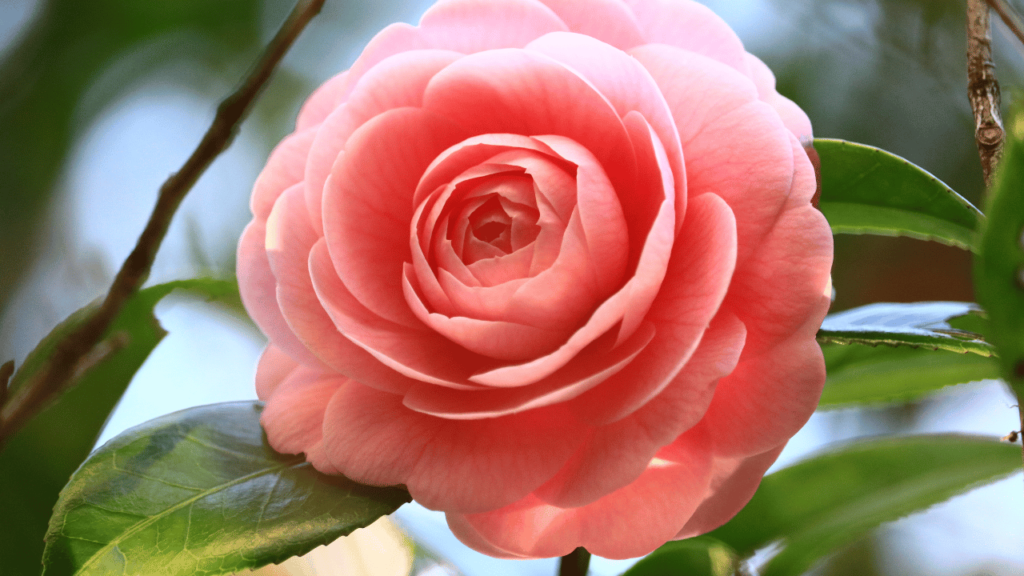
These flowers are typically evergreen, which means they retain their leaves year-round. This makes camellias an excellent choice for adding color and beauty to gardens during the winter months when many other plants are dormant. They can be grown as shrubs or small trees, depending on the variety.
To care for camellias, they prefer a well-draining, slightly acidic soil. They thrive in partial shade, as direct sunlight can scorch their delicate petals. Regular watering and occasional fertilizing will help them stay healthy and produce abundant blooms.
Camellias have been cherished for centuries and are often associated with elegance and beauty. They make a wonderful addition to gardens, and their blooms can also be used in floral arrangements to add a touch of grace and charm.
Hellebores
Hellebores, also known as Lenten roses, are a group of perennial flowering plants in the genus Helleborus.
These lovely flowers are native to Europe and parts of Asia. They are known for their ability to bloom in late winter or early spring, often during the Christian season of Lent, hence their common name “Lenten roses.” Hellebores come in various colors, including shades of white, pink, purple, and even green.
One of the unique features of hellebores is their ability to tolerate shade, making them a perfect choice for shady areas in the garden. They prefer well-draining soil and thrive in moist, woodland-like conditions. Hellebores are also deer-resistant, which is a bonus for gardeners dealing with pesky deer visitors.

In terms of care, hellebores are generally low-maintenance plants. They are known for their long-lasting blooms, often lasting for several weeks. Deadheading the spent flowers can help encourage new growth and extend the blooming period. Additionally, hellebores are toxic if ingested, so it’s important to handle them with care and keep them away from children and pets.
These captivating flowers bring a touch of elegance and beauty to any garden, especially during the early spring when they bloom. With their unique colors and ability to thrive in shade, hellebores are a popular choice among garden enthusiasts.
Snowdrops
Snowdrops, also known as Galanthus, are a group of small, bulbous plants that belong to the Amaryllidaceae family.
These lovely flowers are native to Europe and parts of Asia. They are known for their early blooming, often peeping through the snow in late winter or early spring, which is why they are called “snowdrops.” Snowdrops have small, bell-shaped white flowers that hang down from a slender stem. Some varieties may also have green markings on their petals.
Snowdrops are a symbol of hope and renewal, as they are often the first flowers to bloom after the winter. They are a favorite among gardeners for their ability to bring a touch of beauty and optimism to the garden during the colder months.

In terms of care, snowdrops are relatively easy to grow. They prefer moist, well-draining soil and can tolerate both sun and shade, although they tend to thrive in partial shade. These flowers are known for their naturalizing ability, meaning they can multiply and spread over time, creating a beautiful carpet of white blooms.
Snowdrops are a delightful sight to behold and a sure sign that spring is on its way. Their delicate beauty and resilience make them a beloved addition to gardens and a symbol of hope for the changing seasons.
Witch Hazel
Witch hazel, scientifically known as Hamamelis, is a flowering shrub native to North America and some parts of Asia.
One of the unique things about witch hazel is its ability to produce flowers in the fall or winter when most other plants are blooming. It’s like a little burst of color during the colder months! The flowers are usually yellow or orange and have a lovely, delicate appearance.
But what makes witch hazel even more special are its medicinal properties. The bark and leaves of the witch hazel plant contain natural compounds that have been used for centuries to treat various skin conditions. Witch hazel extract is often used as a natural astringent, which means it can help tighten and tone the skin. It’s commonly used to soothe and reduce inflammation, making it a popular ingredient in skincare products.
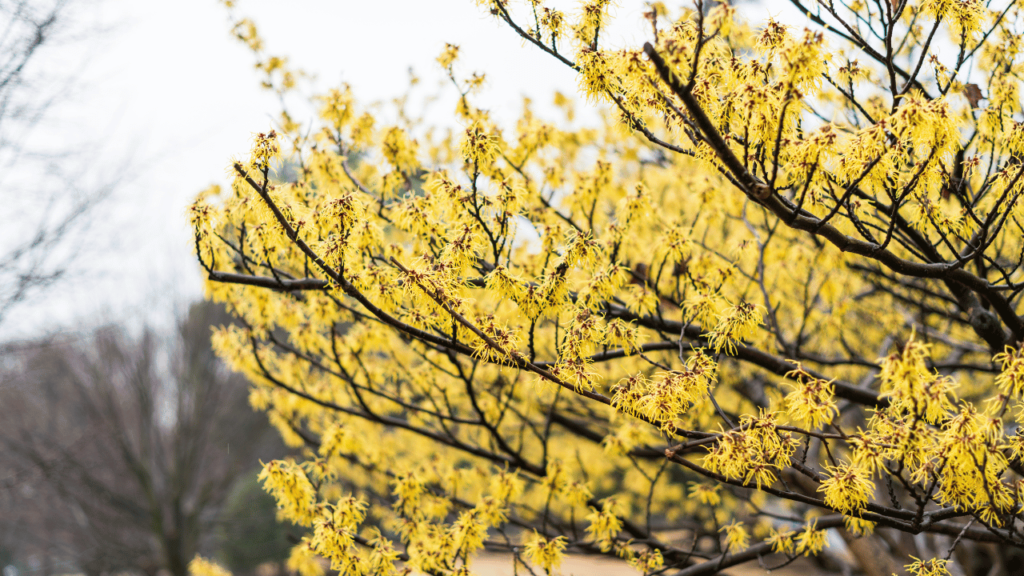
In addition to its skincare benefits, witch hazel is also known for its antioxidant and anti-inflammatory properties. Some people use it to relieve minor skin irritations, insect bites, and even hemorrhoids. It’s like a little multitasking wonder of nature!
If you’re interested in trying witch hazel for your skin, you can find it in various forms like toners, creams, and even pure extract. Just make sure to do a patch test first to make sure you don’t have any adverse reactions.
So, there you have it! Witch hazel is a beautiful plant and a natural skincare ally.
Cyclamen
Cyclamen is a genus of flowering plants that belong to the family Primulaceae. These beautiful flowers are native to the Mediterranean region and parts of Europe.
Cyclamen flowers are known for their unique shape and vibrant colors. They have delicate, upswept petals that give them a distinctive appearance. The flowers come in various shades, including pink, purple, white, and red, with some varieties even having beautifully patterned petals.
One interesting thing about cyclamen is that their flowers bloom during the colder months, typically from late winter to early spring. They’re like little bursts of color during the winter season, bringing joy and beauty to gardens and indoor spaces.
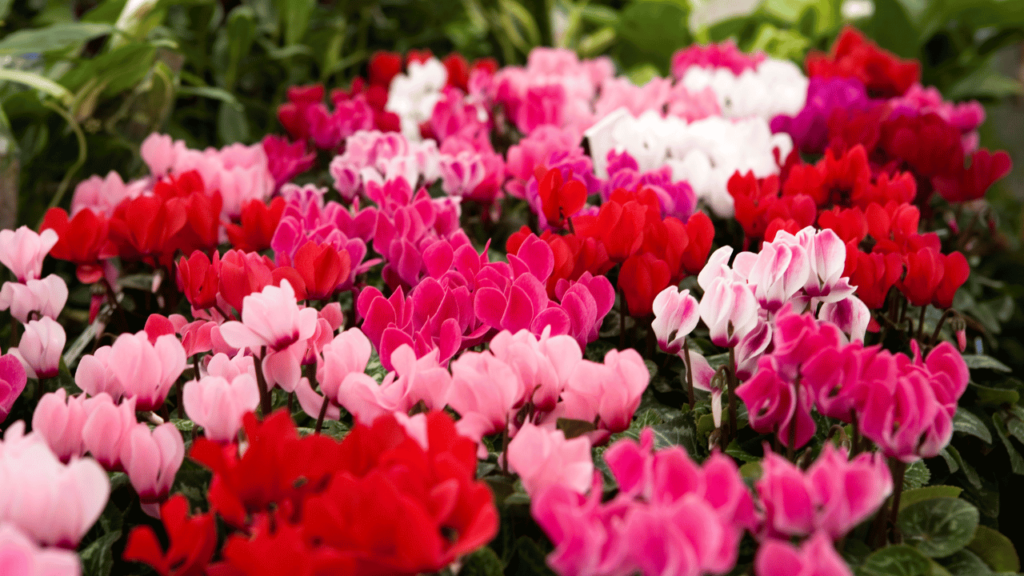
Cyclamen plants have heart-shaped leaves that grow in a rosette pattern. They prefer cool temperatures and partial shade, making them a popular choice for indoor plants or outdoor gardens in temperate regions. With the right care, cyclamen plants can bloom for several weeks, adding a touch of elegance to any space.
It’s worth noting that cyclamen plants are toxic to pets, so it’s important to keep them out of reach. If you’re considering adding cyclamen to your home or garden, make sure to place them in a safe location.
Overall, cyclamen flowers are a delightful addition to any floral display. Their unique shape, vibrant colors, and winter blooming make them a favorite among gardeners and flower enthusiasts.
Winter Aconite
Winter aconite, also known as Eranthis, is a charming little flower that blooms in late winter or early spring. It’s native to Europe and is known for its bright yellow flowers that pop up even when there’s still a chill in the air.
These small, cup-shaped flowers are a sight for sore eyes after a long winter. They have a cheerful and sunny appearance, bringing a burst of color to gardens and woodland areas. Winter aconite flowers usually have six to eight petals and a cluster of bright yellow stamens in the center.
One interesting thing about winter aconite is that it’s one of the earliest blooming flowers of the year. It’s like a little herald of spring, signaling the arrival of warmer days ahead. Despite its delicate appearance, winter aconite is quite hardy and can withstand cold temperatures.

Another cool fact about winter aconite is that it’s a member of the buttercup family. So, you can think of it as a tiny, golden relative of those familiar buttercup flowers you see in meadows during the summer.
If you’re thinking of adding winter aconite to your garden, they prefer moist, well-draining soil and partial shade. They can be planted in clumps or drifts to create a beautiful carpet of yellow blooms.
So, there you have it! Winter aconite is a delightful flower that brings a burst of sunshine to the late winter landscape.
Winter heath
Discover the enchanting winter heath flower, scientifically known as Erica carnea, a delightful bloom that graces the winter months with its presence. These petite flowers boast delicate, bell-shaped blossoms, available in an array of colors including pink, purple, and white. In the midst of winter when many plants lie dormant, winter heath flowers emerge, adding a charming burst of color to gardens and landscapes. Beyond their aesthetic appeal, these flowers serve as magnets for pollinators like bees and butterflies.

Winter heath flowers have specific growth requirements for optimal development. They thrive in well-drained, slightly acidic soil, emphasizing the importance of avoiding waterlogged conditions to prevent root rot. Ideal locations for planting include areas that receive full sun to partial shade, ensuring the flowers receive at least a few hours of sunlight daily. Proper watering is crucial, maintaining consistently moist soil without excessive saturation. Applying a layer of mulch around the plant’s base aids in moisture retention and helps regulate soil temperature. By meeting these requirements, your winter heath flowers will thrive, contributing beauty to your garden throughout the winter season.